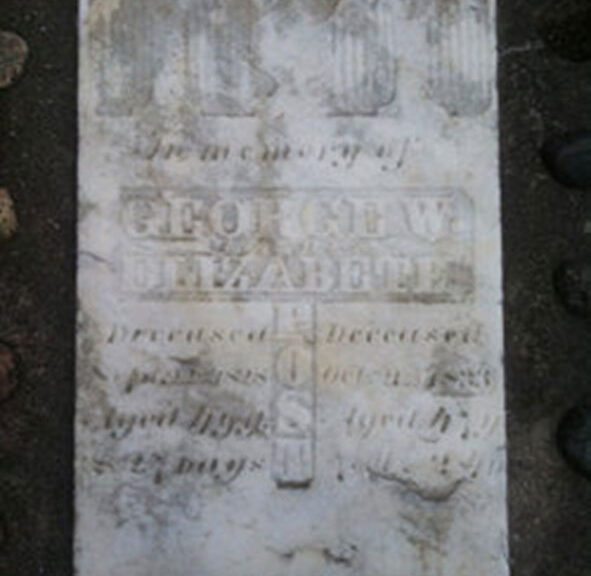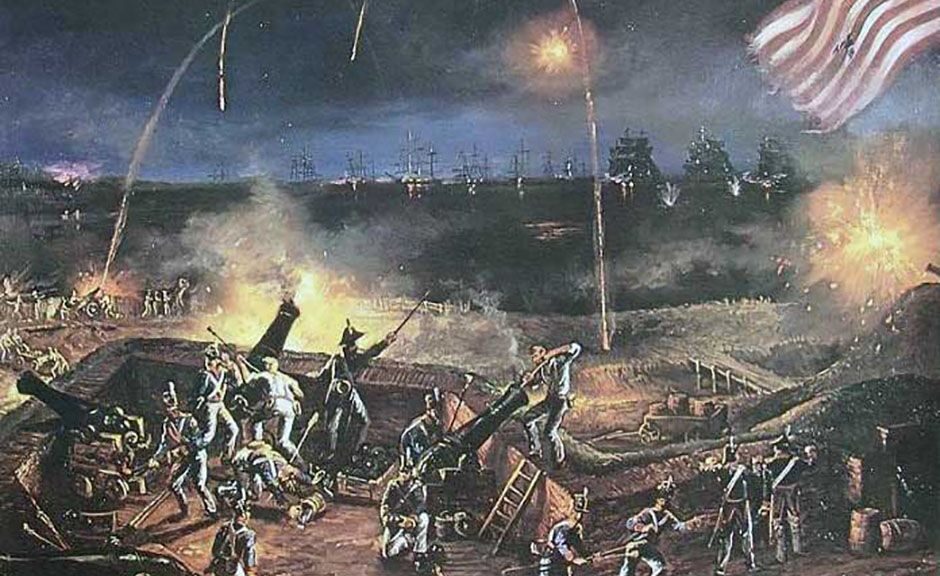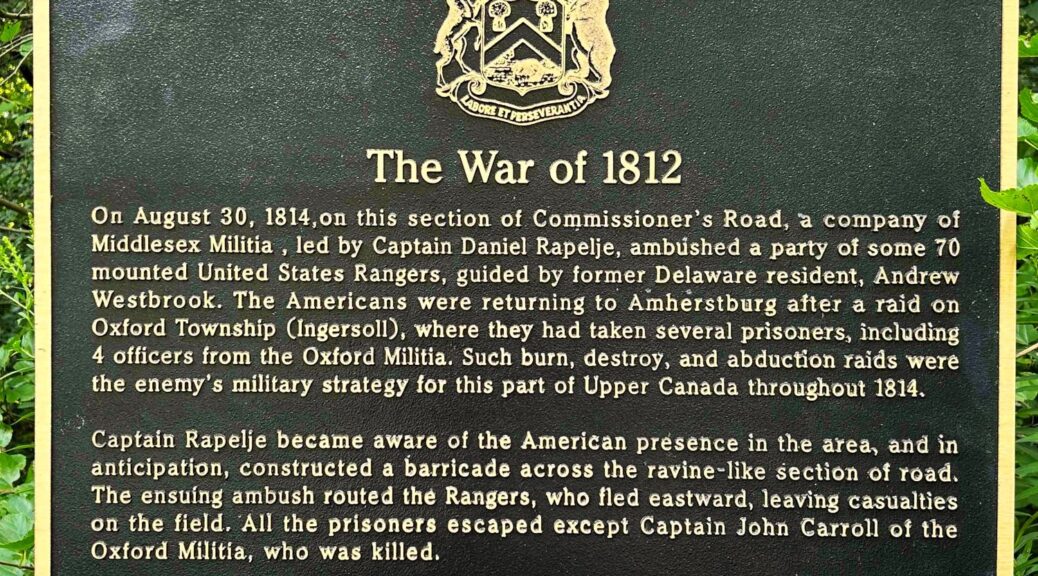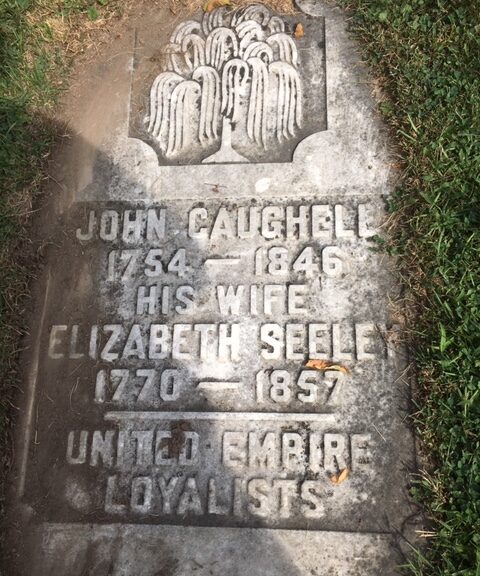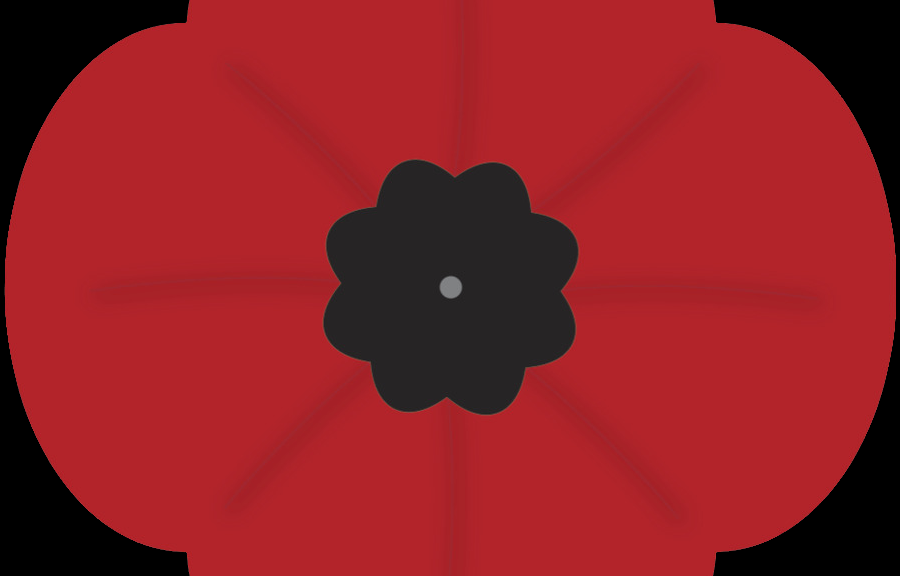Category Archives: Veteran
War of 1812 Veteran
George Washington Post
3rd Regt York Militia
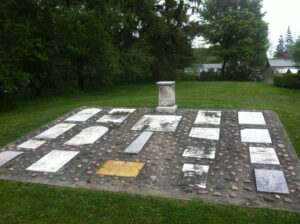 George Washington Post was born in Hebron, Tolland County, Connecticut on August 26, 1779. His parents, Jordon Post, a clockmaker, and Abigail Loomis, immigrated to the Town of York in 1790.[1]
George Washington Post was born in Hebron, Tolland County, Connecticut on August 26, 1779. His parents, Jordon Post, a clockmaker, and Abigail Loomis, immigrated to the Town of York in 1790.[1]
Records list George as a bachelor living in York from 1799 to 1802.[2] He relocated to the Township of Scarboro (Scarborough) in 1802 or 1803 and by 1804 he is recorded as a resident.[3] He married Elizabeth Anna Knowles (1786 -1833) in 1805 and they had ten children: John, Asa, George Washington II, Jordan, Robert, Hiram, Henry, Sybil, Anna and Sarah.
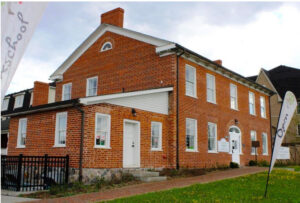 George apprenticed as a barkeeper to William Moore in York as early as 1802[4] before receiving a license for an inn at Highland Creek in 1811, which was the first inn in Scarborough.[5] He purchased land in Pickering along Kingston Road in 1812 and built a large brick family home. This home also served as a stagecoach stop and was optimally positioned given its location along the most significant east-west route in the province’s early history, which linked York and Kingston.
George apprenticed as a barkeeper to William Moore in York as early as 1802[4] before receiving a license for an inn at Highland Creek in 1811, which was the first inn in Scarborough.[5] He purchased land in Pickering along Kingston Road in 1812 and built a large brick family home. This home also served as a stagecoach stop and was optimally positioned given its location along the most significant east-west route in the province’s early history, which linked York and Kingston.
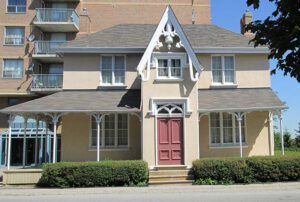 During the War of 1812, George served as a private in the 3rd Regiment of York Militia. This regiment mustered from the present-day City of Toronto (Scarborough, York and Etobicoke), Region of York (Markham) and Region of Durham (Pickering and Whitby).[6] He served in Captain Thomas Hamilton’s Company from November 25 to December 24, 1812,[7] and was on duty at Scarborough with a cavalry company as a courier from April 25 to 24 Aug 1813.[8] His brother, Jordan Post, was captured at Fort York on 27 Apr 1813, while also serving in the 3rd Regiment of York Militia.[9]
During the War of 1812, George served as a private in the 3rd Regiment of York Militia. This regiment mustered from the present-day City of Toronto (Scarborough, York and Etobicoke), Region of York (Markham) and Region of Durham (Pickering and Whitby).[6] He served in Captain Thomas Hamilton’s Company from November 25 to December 24, 1812,[7] and was on duty at Scarborough with a cavalry company as a courier from April 25 to 24 Aug 1813.[8] His brother, Jordan Post, was captured at Fort York on 27 Apr 1813, while also serving in the 3rd Regiment of York Militia.[9]
George Washington Post contributed greatly to the local community. He is first listed as an elected assessor in Pickering at a Township meeting on March 6, 1815. He subsequently held many other important township offices.[10]
He died on 22 Sept 1828 at 49 years of age. His wife, Elizabeth, died a few years later on 21 Oct 1833 at 47 years of age. They are both buried in the Ley Family Cemetery and Potters Field in Ajax, Ontario. It is unknown why this is the location of their burial, but sons Asa and Henry, as well as a granddaughter, are also buried in this location.
 The Post name continues to have prominence in the Ajax and Pickering area. George’s son Robert built an inn around 1831 near the location of the inn formerly operated by his father. This building, which survives today at 365 Kingston Road East, continues to be known as the “Old Post Inn” and was designated by the Town of Ajax under Part IV of the Ontario Heritage Act (By-law 148-92) as a property that is architecturally and historically significant to the community. George’s son Jordan built Post Manor at the intersection of Kingston Road and Brock Road in the City of Pickering. It continues to be an important landmark in the community and is also designated under Part IV of the Ontario Heritage Act. Post Cemetery is located adjacent to Post Manor on the southwest corner of Kingston Road and Brock Road and is the final resting place of Jordan Post and his wife Matilda. George’s son George Washington Post II built a residence, known as “Post Hill” or “Field House,” at the crest of Kingston Road (132 Kingston Road West) in Ajax, which is a fine example of Gothic Revival architecture and continues to be an important landmark in the community. George’s grandson Albert Asa Post (son of Asa) became a prominent architect in the late 19th century and designed numerous institutional buildings across Ontario and New York State.
The Post name continues to have prominence in the Ajax and Pickering area. George’s son Robert built an inn around 1831 near the location of the inn formerly operated by his father. This building, which survives today at 365 Kingston Road East, continues to be known as the “Old Post Inn” and was designated by the Town of Ajax under Part IV of the Ontario Heritage Act (By-law 148-92) as a property that is architecturally and historically significant to the community. George’s son Jordan built Post Manor at the intersection of Kingston Road and Brock Road in the City of Pickering. It continues to be an important landmark in the community and is also designated under Part IV of the Ontario Heritage Act. Post Cemetery is located adjacent to Post Manor on the southwest corner of Kingston Road and Brock Road and is the final resting place of Jordan Post and his wife Matilda. George’s son George Washington Post II built a residence, known as “Post Hill” or “Field House,” at the crest of Kingston Road (132 Kingston Road West) in Ajax, which is a fine example of Gothic Revival architecture and continues to be an important landmark in the community. George’s grandson Albert Asa Post (son of Asa) became a prominent architect in the late 19th century and designed numerous institutional buildings across Ontario and New York State.
Thomas Kains
HMS Devastation
Royal Navy
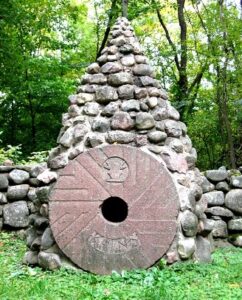
Thomas Kains, Lieutenant, HMS Devastation, Royal Navy
Thomas Kains was born in 1790, in Chatham, Kent, England, son of a boatswain in the Royal Navy. In 1804, at the age of 14, he joined the Royal Navy as a midshipman on none other than the HMS Agamemnon, the three-deck, 64-gun man-of-war that was said to be Horatio Nelson’s favorite.
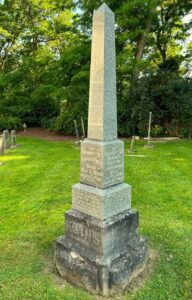
At 15, Thomas Kains was promoted to clerk on the HMS Hyacinth, an 18-gun sloop, on which he served from 1805-1810. Thus, he reached manhood during the tumultuous Napoleonic Wars, engaging in many of its epic naval battles. Kains, a junior officer having been promoted to the appointment as Ship’s ‘purser’. “The purser is the officer entrusted to receive the provisions and victualling stores, to keep and distribute the same to the ship’s company, and, upon particular and urgent occasions, to purchase and provide, and finally to account for the same.

By 1813, Thomas Kains had been promoted to purser aboard the HMS Devastation, an 8-gun bomb vessel. HMS Devastation was part of Admiral Horatio Nelson’s fleet of 27 Royal Navy ships which engaged a larger combined Spanish and French fleet of 33 ships at Trafalgar, off the coast of Spain. Although outnumbered by ships and men, it was an overwhelming victory for Admiral Nelson, having not lost any ships in his fleet. Final Battle estimates were that the enemy lost 7,000-8,000 men captured as POW, 4.395 KIA, 2,541 WIA, 22 ships captured by the British, with one destroyed. The British lost 458 KIA and 1,208 WIA. Admiral Nelson was killed on his flagship ‘ HMS Victory‘ during the battle. Thomas Kains would later serve on HMS Victory during the Crimean War 1854-56.

In the spring of 1814, Napoleon had been defeated in Europe and banished to Elba. Britain shifted resources to quell American attempts to invade Canada, initiated in 1812. But, instead of merely defending Canada, Britain went on the offensive.
In Aug 1814, Thomas Kains’ ship HMS Devastation was dispatched to engage in what became known as the Battle of Washington.

On 17 Aug 1814, Devastation, Seahorse, Euryalus, Ætna, Meteor, Erebus and Anne were detached from a British fleet in Chesapeake Bay and moved up the Potomac River to bombard Fort Washington.
In the Battle of Washington, British troops met with light resistance. Caught by surprise, President Madison, government officials, residents who could flee and most military units, hastily abandoned the American capital.
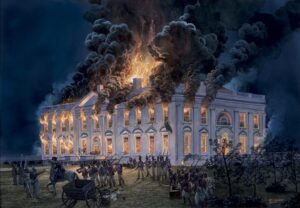
On 24 Aug 1814, Thomas Kains was part of the British company charged with destroying the White House, (known then as the Presidential Residence). Upon entering the building, they found a dinner prepared for about forty people. They ate heartily of the sumptuous food and drank the vintage wine. Then they gathered what souvenirs they could carry and set the White House ablaze. Much of Washington was torched, as the British had resolved to burn all government buildings.
The White House was substantially gutted by the fire, but not completely destroyed. Whitewash was used during its restoration, to cover the smoke damage and it was only then that it became know as the White House.
British forces turned their attention north to Baltimore, intent on exacting revenge on the notorious privateer-operated clipper ships which were harassing the British Merchant Navy, while outrunning and taunting Royal Navy battleships. But the cannons at Fort McHenry guarded the entrance to Baltimore Harbor.
On the 12 Sept 1814, Devastation, Erebus, Meteor, Ætna, Terror, and Volcano were deployed from Chesapeake Bay up the Patapsco River, in preparation for the attack on Baltimore.

The bombardment of Fort McHenry began at 5 a.m. on the morning of September 13. Devastation and her five sister ships fired rockets and mortars at Fort McHenry for 25 hours, but the defenders held. At 6 a.m. the following morning, bombardment ceased.
The most memorable outcome of this engagement was not military in nature, but a poem penned by a young American lawyer named Francis Scott Key, who happened to be on one of the British ships to negotiate the release of prisoners captured at the Battle of Washington, three weeks before. He had watched throughout the night, the red glare of the British rockets and cringed at the sound of exploding bombs. To his amazement, in the dawn’s early light of 14 Sept, after 1,500 bombs and rockets had fallen, the American flag hoisted at Fort McHenry was still flying. The poem, which was later renamed and set to music, became America’s national anthem, the Star Spangled Banner. Thomas Kains had delivered the fireworks.
Despite their repulse at Baltimore, the British were satisfied with their diversionary raids, especially the burning of Washington. In Canada, Governor General Prevost proclaimed that the burning of the proud American capital was just retribution for the sacking and burning of York (later renamed Toronto) by American troops in 1813.
Kains remained as purser with the HMS Devastation until August 1815, after the final defeat of Napoleon at Waterloo, which brought years of war to an end with the Treaty of Paris. The Treaty of Ghent ended the War of 1812-15.
In 1818, Thomas Kains settled briefly in Carillon, Quebec, and then in Grenville. In 1821, he married Mary McMillan, the eldest daughter of Grenville’s founding father, Archibald McMillan. Nine of their children were born in Grenville.
Thomas Kains was engaged for some years in the saw milling and grist milling business in Grenville, where he was also a church warden and justice of the peace. During this time, Kains was appointed, with Denis-Benjamin Papineau, commissioner of roads and bridges, to build the Grenville to Hull road. A cairn was erected in Grenville in honour of Thomas Kains (supporting document image).
Steamboats had started operating on the Ottawa River in 1823. In 1830, Kains entered the employ of McPherson & Crane, as captain of their steamer Shannon. He shuttled cargoes of mail, passengers and goods between Grenville and Bytown until 1841. In 1845, he purchased the steamer, Princess Royal, and ran his own company until 1853.
In the 1851 census, Thomas Kains (61), appears with his wife, Mary McMillan (50), and three of their offspring — Thomas (28), Isabella (18) and Zebee (16). The family was living on Range 1, Lot 7 — about where the old Canadian National railroad bridge once crossed the Ottawa River to Hawkesbury.

But Kains’ Royal Navy career was not yet over. At the onset of the Crimean War, Kains was still a half-pay officer in the Royal Navy. On 31 Dec 1853, at the age of 63, he was called back to active service as paymaster aboard HMS Victory, which had been Nelson’s flagship at Trafalgar. By that time Victory had been converted to a hospital ship, and docked at Portsmouth, England. He held this post until September, 1854. Kains died shortly thereafter, in Montreal, on 9 May 1855.
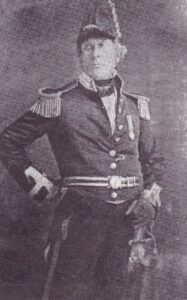
The Royal Museum at Greenwich displays a very similar uniform which had belonged to purser John Lord who had fallen to his death from high in the rigging. This pattern of uniform had the cuffs and collar changed from white to red (Windsor colours) by HM King William IV in 1832.(image attached for confirmation).
While commissioned officers and warrant officers were meant to wear what was essentially the same uniform, rank could be discerned by whether the coat was double- or single-breasted, the arrangement of buttons and the width of gold lace on the collar and cuffs, as well as on the epaulettes. That this is a warrant officer’s uniform is indicated by the single-breasted coat with its grouping of eight buttons in pairs. In addition, the purser would have only worn one full epaulette and one scale. In this case the photo of John Kains has two full epaulettes, which may have reflected his promotion to the appointment in 1853 to that of Paymaster on HMS Victory.
A rare photo of Naval Officer Thomas Kains shows him ‘decorated’ and in the dress uniform of a Royal Naval Officer entitled ‘Cpt Thomas Kains’. The uniform is similar to that worn by an 1812 purser, or possibly a Warrant Officer.
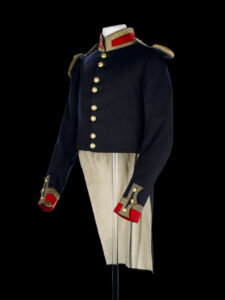
In the intervening years, Kains’ younger brother, George, and several of his own offspring had left Grenville and established themselves in St. Thomas, Ontario. Both Thomas Kains and Mary McMillan are buried there.
Thomas Kains’ epitaph reads as follows:
“Then are they glad because they are at rest, and so we bringeth them into the heaven where they would be.”
Archibald Kains (1865–1944), the grandson of Thomas Kains, journeyed to Washington, DC, in 1939, to return to President Franklin Delano Roosevelt some sterling silver and a small medicine chest that his grandfather had pillaged from the White House on 24 Aug 1814.
Supporting Documents: George Rainey’s bio sketch of Thomas Kains career. Photos of Captain (RN) Thomas Kains, British Naval Muster Pay List, graveyard obelisk, Grenville cairn, naval ships and naval engagement paintings.
Daniel Rapalje
1st Regiment Middlesex Militia
Captain Daniel Rapalje, 1st Regiment of Middlesex Militia
Born 8 Nov 1774 Long Island City, Queens, NY to George Rapelje and Aletta Lent appears on the 1790 Census for Newtown Twp., Queens, NY , apparently a wealthy landowner.
Married Elizabeth Vandervoort 24 Sep 1795 at Long Island City, Queens, NY. She was born 1776 Queens, NY and died 27 Feb 1865 at St. Thomas, Elgin
By 1799 they had migrated to Erie, NY, moving on to to Woodhouse Twp, Norfolk County, Upper Canada (Long Point Settlement) by 1802.
Rapelje later received 200 acres of land on the south side of the Talbot Road at Kettle Creek.
1810 family had moved to south side of Talbot Road at Kettle Creek in Elgin County, UC
Daniel Rapalje was a miller, establishing a log grist mill, eventually dividing a portion of his land into town lots.
Founder of what is now St. Thomas, Ontario.
Children:
- George James
- Elsie
- Aletta
- Catherine,
- Lambert
- Jeronimus
- Margaret
- John
- Daniel
- Elizabeth
- Hiram
- Henry
- Mary
War 1812-15 Military Service
Joined 1st Regiment, Middlesex Militia becoming a Captain
He is a veteran of Lundy’s Lane and numerous other battles
Ambush at Reservoir Hill, London
On 30 Aug 1814, Captain Rapalje learned of a contingent of 70 mounted American Rangers led by the ‘turncoat’ former Delaware resident Andrew Westbrook, who were returning to Amherstburg with captured militia officers, after a raid on what is now Ingersoll, Ontario.
Capt Rapalje quickly assembled and led a company of 1st Regt Middlesex Militia to the ravine at Hungerford Hill (now known as Reservoir Hill), along the return route of the Americans.
His men set up a barricade across the road in the ravine.
When the surprise ambush was sprung, the US Rangers scattered, leaving many casualties on the field.
All the prisoners escaped except Captain John Carroll of the Oxford Militia who was killed during the ambush.

There is a City of London historic plaque, located at the entrance of Reservoir Park (864 Commissioners Rd W) commemorating Capt Rapalje’s ambush.
Daniel Rapalje was a miller, and in 1814 he establishing a log grist mill, eventually dividing a portion of his land into town lots.
According to Rev’d Canon Nick Wells, Daniel Rapalje donated the land for the Old St. Thomas Church and graveyard.
The settlement that Rapelje established formed the nucleus of the city of St. Thomas.
Founder of what is now St. Thomas, Ontario.
He died 1 Oct 1828.
Citation: Ermatinger, Charles Oakes, The Talbot Regime, or, the First Half Century of the Talbot Settlement, St. Thomas: The Municipal World, 1904.
Supporting documents: (1) Col Thomas Talbot’s Roll of Service of War 1812 1st Regt Middlesex Militia combatants (2) photo of Reservoir Hill Ambush plaque
William Drake
Captain Drake’s Company
2nd Regiment Norfolk Militia
Captain William Drake UEL, Captain Drake’s Company, 2nd Regiment Norfolk Militia
Born 14 June 1761 at Goshen, Orange County, New York Colony to Benjamin Drake and Abigail Knapp.
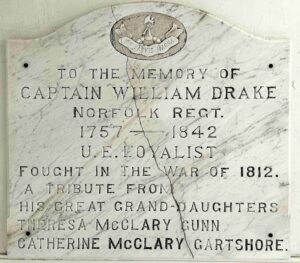 Joined the Royal Standard – during the Revolutionary War 1775-1783) Serving in Butler’s Rangers.
Joined the Royal Standard – during the Revolutionary War 1775-1783) Serving in Butler’s Rangers.
He was discharged and settled at Digby, Nova Scotia in 1783.
He married Margaret Dowdle in 1788. She was born 13 Nov 1768 in Goshen, Orange, NY and died 31 Dec 1848 in St. Thomas.
Their children:
- Richard
- Mary
- Phineas
- Thomas
- Anne
- Margaret
- William
- Benjamin
- James
- Eleanor
By 1792 he and Margaret were in Hamilton where Richard was born
by 1799 they were in St. Thomas.
He joined the Norfolk Militia during the War of 1812-14, serving as a Captain commanding his own militia company.
In 1816 he applied for a land grant at Long Point.
He died 10 June 1842 at St. Thomas, ON.
Supporting Documents National Archives Canada: Pay receipt in Capt Drake’s signature, and a pay record for Capt Drake’s Company.
Photos from Old St. Thomas Church of Capt Drake marble wall plaque and gravestone in the churchyard.
John Caughell
Flank Company1st Regiment Lincoln Militia
Pte John Caughell UEL, Flank Company, 1st Regt Lincoln Militia
Born in Holland, but there is little history written on his early life.
During the American Revolution ,John Caughell and his brother George Caughell served as privates in Butler’s Rangers. John Caughell was in Niagara in 1783 and 1784 and was listed on the rations list as a single man.
During the War 1812-15, John Caughell served in the Flank Company of 1st Regiment of Lincoln Militia.
For his War of 1812 service John Caughell received a grant of 100 acres.
He married Elizabeth Seeley c 1795. She was born c 1770 in Stamford, CT and died 1857 in St. Thomas.
Their children:
- David
- Benjamin
- John Jr
- Peter
- James
- Elizabeth
- George Alexander
- Mary
- Margaret
- Jemima
- Levina Jemima
John’s and Elizabeth’s children as listed below, each received an Order in Council.
- David
- Mary m John Lee
- Peter
- Benjamin
- Jemima m Peter Charlton
- James
- George
- Elizabeth m Joseph Marlatt
- John
- Margaret m. Jacob Sporbeck and Alexander Allen
John Caughell UEL died 5 Aug 1846 at the age of 92 years old at Yarmouth Twp., Elgin County
Supporting documents include Index of Land Claim Certificates and photo of gravestone in Old St. Thomas Churchyard.
Henry Warren
3rd Regiment Lincoln Militia
Henry Warren was born 1772 in Trois-Riveres, Mauricie, Lower Canada to John Warren of the Kings Own 8th Regiment and his wife Susan.
The family moved to Bertie Twp., Lincoln (later Welland).
Henry married Catherine Aygler on 23 Aug 1792 at St. Paul’s Anglican in what is now, Fort Erie.
She was born in 1774 and died 17 Jun 1828 in Bertie Twp. She is buried in St. Paul’s churchyard.
They had twelve children:
- Mary
- John
- William
- Horatio Nelson
- Edward Edmund
- Henry Jr.
- Catherine
- Robert
- Eliza
- Thomas
- Archange
- Alexander
In 1802 Henry and his brother, John Warren, Jr. were granted the right to operate the ferry at Fort Erie on 9 Nov 1802.
War of 1812-14 Henry served in the 3rd Regiment Lincoln Militia in the rank of Major.
After the death of his wife, Catherine in 1828, Henry moved to Elgin County where his daughter, Catherine, lived.
He died 29 Mar 1858.
Archives of Canada pay records 25th Sept 1812-24th Oct 1812 document provided.
Henry Mandeville
Flank Company
1st Regiment Middlesex Militia
Born 12 Dec 1797 Schenectady, NY to David Mandeviel and Dinah Vanderhoof.
Served Flank Company 1st Regiment Middlesex Militia.
Received land for this service.
Married Frances Oswell b 1807 South Kortright, NY in 1831.
Frances and Henry had a son Charles in 1832 and Frances died soon after. Frances, the first wife is buried with Henry at Old St. Thomas Churchyard.
Henry remarried 20 June 1834 to Nancy Ann Thayer. Nancy Ann Thayer was born 21 Sep 1813 at Port Talbot. She died in 1861 in St. Thomas.
Henry died 9 Feb 1837.
Nancy Ann had a son, Sylvester Mandeville on 13 Sep 1837.
Frederick Couse
Captain, Chrysler’s Company
2nd Regiment Lincoln Militia
Pte Frederick Couse
Born 2 Aug 1794 in Vineland, Clinton, Twp., Lincoln County, UC
son of Peter Couse and Betsy Snover
Joined Captain Chrysler’s Company, 2nd Regiment Lincoln Militia as a Private.
Received 100 acres for War 1812-15 combatant service.
Moved to Yarmouth Twp, Elgin County.
Married Mary Ensley (b. 10 Mar 1799 d. 21 June 1848 both in Yarmouth) on 3 Sep 1818 in Yarmouth.
Twelve children:
- John
- Frederick (aka Peter)
- Aaron
- Richard
- Moses,
- Della
- Elizabeth
- Rachel
- Albert
- Mary Ann
- Calista
- Ellen
He died 16 May 1867 in Yarmouth Twp.
Muster Roll pay record sent as supporting Document.
However, Frederick Course received a land grant for War 1812-14 service in 2nd Flank Company, 4th Regiment Lincoln Militia.
Archives Canada Land Grant Document requested., but pay record is believed to be most accurate.
James Nevills
1st Regiment Middlesex Militia
Major James Nevills, 1st Regiment Middlesex Militia
Born in either 1789 in Stamford Twp., Lincoln County Upper Canada to Major Thomas James Nevills and Eve Anne DeShired from New Jersey served in 1st Regiment Middlesex Militia as the Adjutant. The adjutant was an officer usually with the rank of Captain.
At the end of the War, he married Elizabeth Mann in 1815 (born 1792 in UC and died at St. Thomas in 1885)
Rose to rank of Major during the 1837-1838 Rebellion / Patriot Wars.
Known Children:
- Matilda
- Elizabeth
- Thomas
- Charles
Died 7 Jun 1861, St. Thomas, Yarmouth Twp, Elgin County.
Supporting Documents:
(1) Service Rolls of 1st Regt Middlesex Militia , compiled by Col Thomas Talbot.
(2) Regimental Order issued 7th Jan 1839 from Commanding Officer Col Mahlon Burwell reviewing the performance of officers of 2nd Regt Middlesex Militia during the 1837 Rebellion / Patriot Wars. Capt. James Nevills’ conduct was commended (as well as several other 2nd Middlesex officers), while gathering and leading militiamen to attack the ‘banditti’ (rebels) who had formed at Oakland.
Capt. James Nevills was promoted to rank of Major at the end of the 1837-1838 Upper Canada Rebellion / Patriot Wars.
In 1830’s James Nevills, a farmer near Port Stanley held several Yarmouth Twp offices including Town Clerk in 1830 and 1833. In his latter years he was also appointed magistrate.

